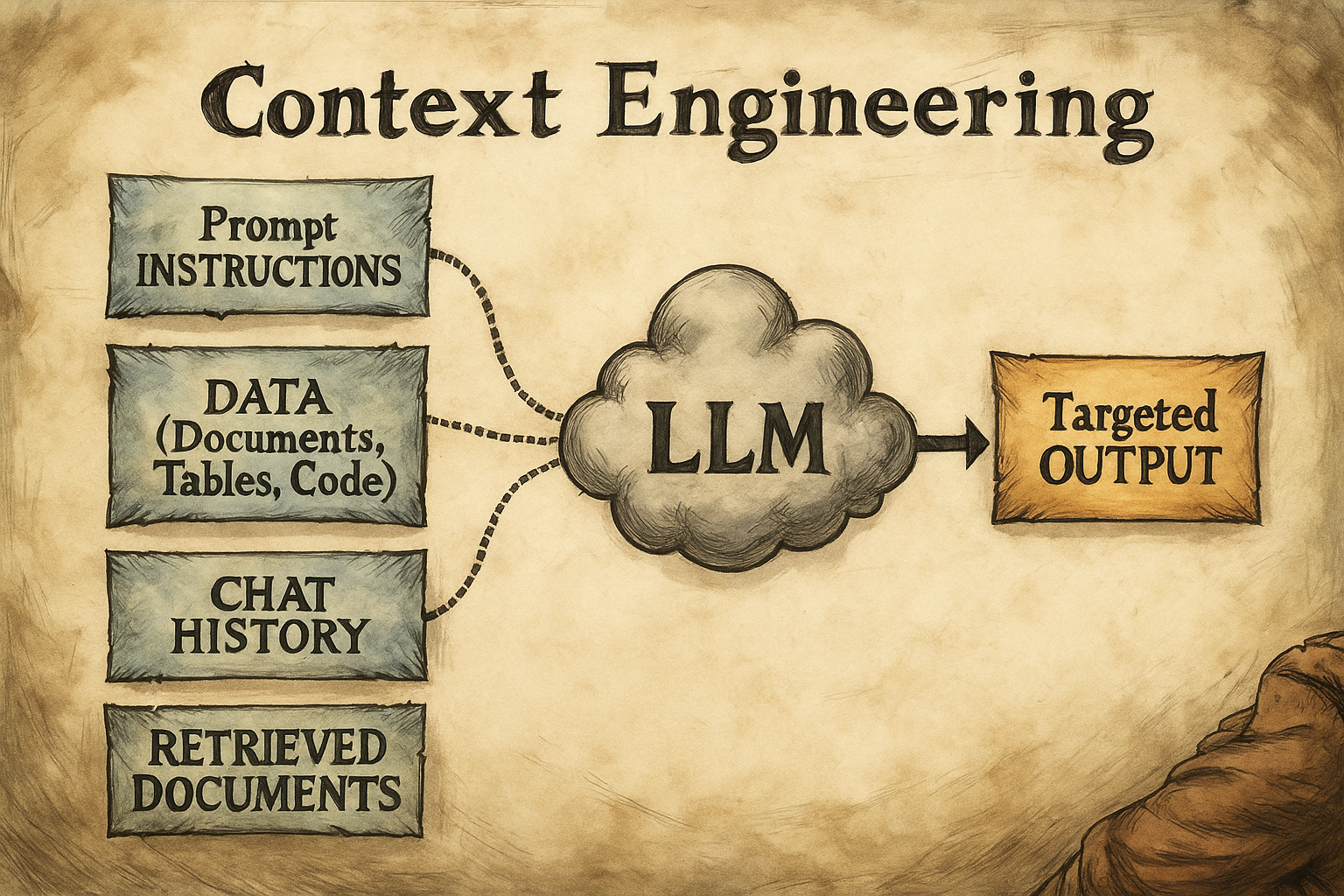
Have you ever talked to an AI, like a smart assistant or a chatbot, and felt like it just didn’t “get” what you really meant? It might give you an answer that’s technically correct but completely unhelpful for your situation. That’s where a new, super important idea called Context Engineering comes in!
What is Context Engineering?
Think of it this way: AI is like a brilliant chef who knows how to cook anything. If you just walk into their kitchen and say, “Make me food!”, what do you think you’ll get? Maybe a sandwich, maybe a fancy cake, or maybe something you didn’t want at all! The chef is smart, but they don’t have enough context to make the perfect dish for you.
Context Engineering is like being a super-helpful customer who gives the chef all the right ingredients and clear instructions so they can make exactly what you want. It’s about preparing the AI with everything it needs to know to do its job well. It’s not just about asking a question; it’s about setting up the entire environment around the AI.
What Happens Without Context Engineering?
If you don’t do Context Engineering, your smart AI chef might make big mistakes! It could:
- Give you generic answers that aren’t useful for your specific needs.
- Provide irrelevant information.
- Even make things up, which we call “hallucinations” in AI-speak.
Think back to our chef. If you just said “make food,” and you’re vegan and allergic to nuts, you might get a delicious steak with peanut sauce! That’s a “context failure” – the chef is great, but they didn’t have the crucial details.
How Does Context Engineering Work? Giving the AI its “Recipe Book”
Context Engineering is a whole system that works before the AI even tries to answer your question. It’s like gathering all the right “ingredients” and “recipes” for our chef. This means carefully choosing and arranging all the information the AI sees.
It goes way beyond just the simple question you type. It includes all sorts of helpful information that guides the AI’s “thinking”.
Key Ingredients in the Context Engineering:
Here are the main types of “context” we give the AI:
- The Rules: This is like giving the chef a set of general rules for the kitchen. For example, “Always use fresh ingredients,” or “Be polite to customers.”
- Background Information/Data: This is all the knowledge the AI needs that isn’t directly in your question.It could be short-term memory, like remembering what you talked about just a few minutes ago in the conversation. It could be long-term memory, like remembering your preferences from weeks ago (e.g., “I’m vegan”).It also involves pulling in real-time information from outside sources, like looking up the current weather online or finding facts in a huge database. This is often called RAG (Retrieval-Augmented Generation), and it helps the AI get accurate, up-to-date facts and avoids making things up.
- Examples (The “Show Me How” Pictures): Sometimes, the best way to teach is to show, not just tell. You give the AI examples of what a good answer looks like. This helps it understand the style and format you expect.
- The “Don’ts” and Boundaries: This tells the AI what it shouldn’t do or how it should format its answers. For our chef, it might be “Don’t use any nuts” or “Present the meal in a square dish.” For AI, it could be:
"Respond formatted as JSON like {'destination': '...', 'days': ...}"This helps ensure the output is safe and usable.
Why All This Effort Matters
Context Engineering is so important because it turns a basic AI into something truly powerful and reliable.
- Reduces Mistakes: By providing all the necessary details, the AI is much less likely to make errors or give irrelevant answers.
- Makes AI More Useful: It allows AI to handle complex, multi-step tasks that traditional AI couldn’t. It’s the difference between a “cheap demo” and a “magical product”.
- Creates Consistency: The AI learns your specific project’s “style” and rules, ensuring its responses are always consistent.
- More Human-Like: It helps the AI understand the subtle cues and nuances of human language, making interactions feel more natural.
Real-World Examples:
- Smart Home Application: Instead of just turning on the heat when it gets cold, a context-engineered smart home also knows if you’re on vacation (so it doesn’t waste energy) or if it’s just a quick cold snap.
- Personalized Diet Plan: An AI fitness coach needs to know your age, gender, weight, activity level, dietary preferences, and even injuries before it can create a safe and effective workout plan just for you. It won’t give you a generic plan that might not be suitable.
- Online Shopping Recommendations: An e-commerce site using context engineering would recommend products not just based on what you clicked before, but also considering the current weather, trends, and your location.
How does context engineering differ from prompt engineering?
| Aspect | Prompt Engineering | Context Engineering |
|---|---|---|
| Primary Focus | Crafting a single, effective input query or instruction to guide LLM output. | Designing and building dynamic systems that supply an LLM with all necessary information to accomplish a task. |
| Scope | What you ask. Limited to phrasing a task. Focuses on a single text string at a moment in time. | How you prepare your model to answer. A superset of prompt engineering. Considers the entire interaction and what fills the context window. |
| Components | Typically involves clever wording and specific phrasing. | Includes: system/instruction prompt, user input, short-term memory/chat history, long-term memory, retrieved information (RAG), tool definitions, responses from tools, structured outputs, and global state. |
| Complexity Level | Effective for simple, self-contained tasks. Often leads to trial-and-error tinkering. | Essential for multi-step, data-rich, or dynamic tasks. Aims for consistent, repeatable frameworks; an architectural approach. Reduces AI failures by addressing context issues. |
| Outcome | Might yield a good result for one input but fail for slightly different cases, requiring further adjustments. | Transforms LLMs from simple chatbots into powerful, purpose-driven systems and autonomous agents. Enhances accuracy and reliability. |
| Key Challenge | Formulating a clever query. | Curating and optimizing the model’s “working memory” each time it is invoked, considering context window limits, formatting, and relevance. |
| Relation to RAG | Does not inherently include RAG; RAG is a separate technique. | RAG is one of the key components context engineering relies on for grounding responses in factual data. Context engineering orchestrates RAG with other elements like memory and formatting. |
So, the next time you interact with a smart AI, remember that a lot of behind-the-scenes “context engineering” is happening to make that interaction as helpful and intelligent as possible!

